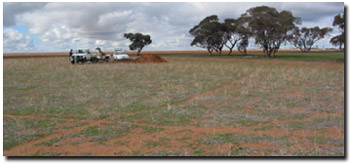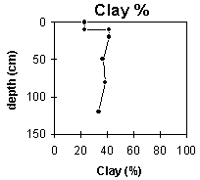ORZC10
| Location: Sea Lake/ Watchupga Rd. | Australian Soil Classification: Vertic (& Calcic), Hypernatric, Red SODOSOL. |
| Geology: Quaternary (Woorinen Formation) overlying Tertiary Parilla Sandstone (within 2 metres of surface). | |
| General Landscape Description: Lower slope of broad subdued N/S trending ridge. | |
| Site Description: Grazing paddock. | Native Vegetation: Mallee. |
 Site ORZC10 Landscape |
Soil Profile Morphology:
Surface Soil
| A1 | 0-10 cm | Brown (7.5YR4/4); sandy clay loam; hardsetting surface; firm consistence (dry); non-calcareous; pH 6.8; abrupt change to: |  Site ORZC10 Profile |
| Subsoil | |||
| B21 | 10-20 cm | Reddish brown (5YR4/4) with many yellowish red (5YR5/8) mottles; medium heavy clay; moderate strong coarse blocky, parting to medium blocky structure; slickensides present; slightly calcareous; strong consistence (dry); pH 8.7; clear change to: | |
| B22 | 20-50 cm | Yellowish red (5YR5/8); medium clay; moderate-strong blocky, parting to moderate blocky structure; slickensides present; moderately calcareous; few (5%) fine earth carbonates; strong consistence (dry); pH 9.1; clear change to: | |
| B23k | 50-80 cm | Yellowish red (5YR5/8) and reddish yellow (5YR6/8); light medium clay; weak coarse prismatic, parting to moderate-strong blocky structure; fine earth carbonates common (15%); very highly calcareous; weak consistence (slightly moist); pH 9.2; clear change to: | |
| B24 | 80-120 cm | Reddish yellow (5YR6/6); medium clay; weak prismatic to polyhedral structure [with some patches of strongly structured material]; weak consistence (slightly moist); highly calcareous; pH 9.2; abrupt change to: | |
| B3 | 120+ cm | Reddish yellow (5YR6/6) with reddish yellow (7.5YR5/8) and brownish yellow (10YR6/8) and white (10YR8/1) mottles; medium clay (sandy); weathering sandstone present; slightly calcareous; pH 6.3. | |
Key Profile Features:
- Strong texture contrast between surface (A) horizon and subsoil (B) horizons.
pH | Salinity Rating | |||
Surface soil (A1 horizon) | Slightly Acid | Low | Sodic | None 1 |
Upper subsoil (10 - 20 cm) | Moderately Alkaline | Low | Strongly Sodic | None 2 |
Deeper subsoil (50-80 cm) | Very Strongly Alkaline | High | Strongly Sodic | None |
Deep subsoil (at 120+ cm) | Slightly Acid | Very High | Strongly Sodic | None |
 |  |  |
 |  |
Horizon | Horizon Depth (cm) | pH (water) | pH (CaCl2) | EC 1:5 | NaCI % | Exchangeable Cations | Boron mg/kg | Field Capacity pF 2.5 | Wilting Point pF 4.2 | Coarse Sand (0.2 - 2 mm) | Fine Sand (0.02 - 0.2 mm) | Silt (0.002 -0.02 mm) | Clay (<0.002 mm) | |||
Ca | Mg | K | Na | |||||||||||||
meq/100g | ||||||||||||||||
A1 | 0-10 | 6.8 | 6.2 | 0.21 | 8.2 | 5.6 | 1.2 | 1.3 | 2.3 | 21 | 10 | 39 | 26 | 7 | 24 | |
B21 | 10-20 | 8.7 | 7.9 | 0.42 | 0.04 | 11 | 13 | 0.6 | 13 | 6.8 | 36 | 19 | 32 | 17 | 6 | 42 |
B22 | 20-50 | 9.1 | 8.3 | 0.6 | 0.07 | 8.8 | 13 | 0.5 | 13 | 6.8 | 35 | 17 | 36 | 18 | 6 | 37 |
B23k | 50-80 | 9.2 | 8.6 | 1.2 | 0.18 | 5.5 | 14 | 0.7 | 8 | 14 | 39 | 20 | 25 | 15 | 6 | 39 |
B24 | 80-120 | 9.2 | 8.5 | 1.3 | 0.2 | 4.5 | 12 | 0.6 | 7.7 | 17 | 30 | 16 | 37 | 18 | 6 | 34 |
B3 | 120+ | 6.3 | 5.8 | 0.92 | 0.14 | 2.3 | 5.6 | 0.3 | 4.7 | 4.3 | ||||||
Management Considerations:
- Management strategies for all soils should aim to increase organic matter levels in the surface soil; minimise the degradation of soil aggregates and porosity; promote the development of stable biopores; improve the calcium status of the cation exchange complex (particularly when sodium is a significant part), and break up any hardpans. Less frequent tillage; using less aggressive implements, and working the soil at optimum moisture content can all assist in maintaining soil aggregation and porosity as well as reducing the breakdown of organic matter.
- The hardsetting surface soil is sodic and disperses moderately to strongly after remoulding. This indicates that structural degradation (e.g. surface sealing, crusting, increased cloddiness) may occur if the soil is cultivated or overstocked in a moist to wet condition. Also, raindrop action on bare surface soil may also promote dispersion and result in surface sealing or crust formation. Surface cover should be maintained to protect the soil against raindrop action. The use of gypsum may also assist in ameliorating the surface soil. Management practices such as minimum tillage, stubble retention and pasture rotation can be used to improve organic matter levels.
- The subsoil is mainly very strongly alkaline, which indicates that phosphorus and trace elements such as iron, manganese, zinc and copper may be poorly available for plants.
- Boron toxicity can also occur in strongly alkaline soils. The boron levels measured in the deeper very strongly alkaline subsoil (i.e. from 50 cm depth) are reasonably high at this pit site and may affect boron-sensitive species (including cereals, pulses, pasture legumes). Concentrations as low as 10 ppm, for example, can reduce lentil yield. Limited data estimates that the threshold level of soluble boron for cereals is 15 mg/kg (Cartwright et al., 1984). Other work at VIDA indicates that where there are low levels of soluble salts boron tolerance can be comparatively high, with little reduction in wheat yield at levels of up to 45 ppm (Quinlan, 2001).
- The level of soluble salts becomes high in the deeper subsoil (from 50 cm depth). This is likely to restrict the growth of deeper-rooted salt sensitive species.
- The deep subsoil (below 120 cm depth) becomes slightly acidic (and would become even more acidic with increasing depth). This is part of the older soil profile developed on the Tertiary Parilla Sandstone.
Cartwright, B., Zarcinas, B.A, and Mayfield, A.H. (1984). Toxic Concentrations of Boron in a Red-Brown Earth at Gladstone, South Australia. Australian Journal of Soil Research. 22. 261-72.
Hobson, K. (2001). Boron Tolerant Lentils. In On The Pulse pamphlet. NRE.
Maschmedt, D. (2000). Agricultural Land Classification Standards used in South Australia’s Land Resource Mapping Program. Department of Primary Industries South Australia.
Quinlan, J. (2001). Sorting out the Boron Problem. Wimmera Farming & Landcare Newsletter. 19-20.
Rengasamy, P. and Churchman, G.J. (1999). Cation Exchange Capacity, Exchangeable Cations and Sodicity. In: Soil Analysis – An Interpretation Manual. (eds. Peverill, K.I et al). CSIRO Publishing.
White, P.F. (1990). Soil and Plant Factors Relating to the Poor Growth of Lupinus species on Fine Textured Soils – A Review. Australian Journal of Agricultural Research 41: 871-890.


